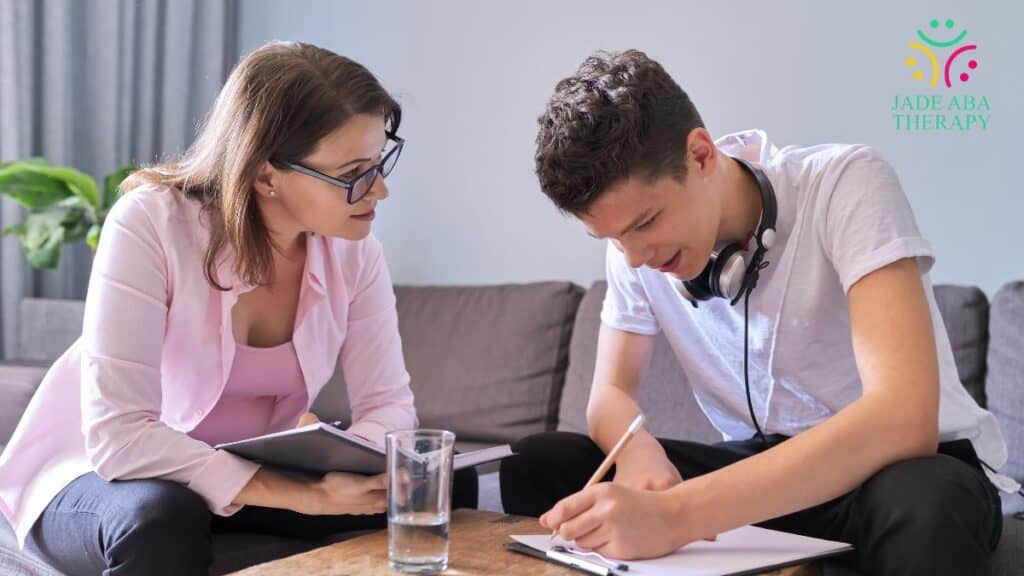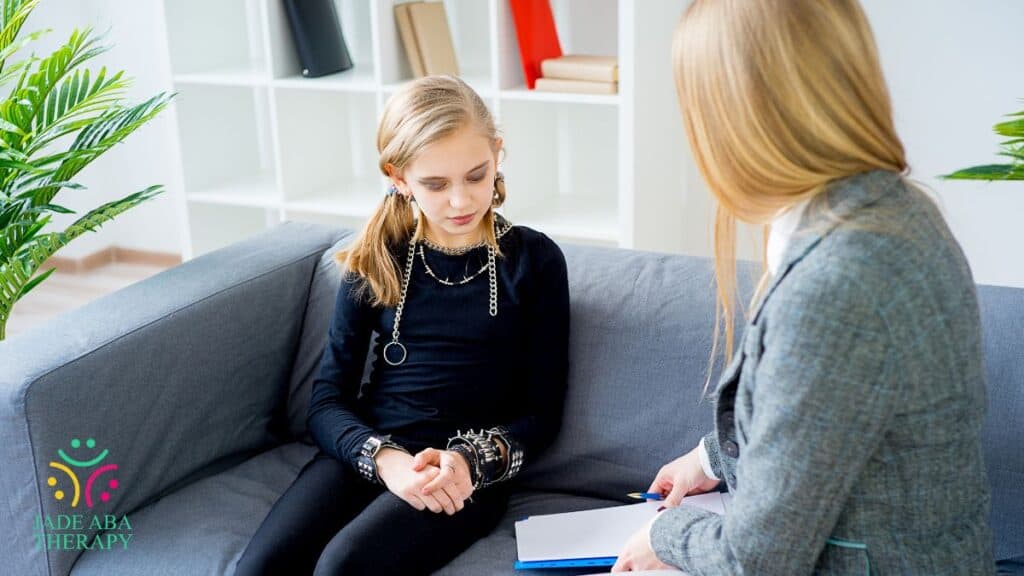Key Points:
- ABA therapy empowers teens on the autism spectrum by teaching real-life skills that reduce conflict, increase independence, and support goals like school success and social connection.
- Therapy breaks tasks into teachable steps, tracks progress with data, and uses relevant settings for practice.
- Early wins build buy-in, and caregivers receive tools to support progress at home.
Teens want less conflict at home, fewer shutdowns, and more say in their lives. Parents want steps that actually work. ABA therapy uses practical teaching, data from real routines, and steady practice to help teens gain control of school, friends, and future goals.
Below, expect a clearer plan for behavior, communication, and independence, plus tools you can use between sessions to keep gains moving.

What Challenges Do Autistic Teens Face Right Now?
Teen years add hormones, harder schoolwork, changing friendships, and more time online. Executive-function demands rise while social rules get less clear. Many teens also deal with anxiety or low mood. A meta-analysis found that 39.6% of children with autism had at least one anxiety disorder.
Concerns like autism and anger in adolescence show why screening and skill building are not optional. Common stress points include:
- School workload: Longer projects, planning, and shifting between classes drain energy.
- Friend groups: Subtle social cues and sarcasm increase misunderstandings.
- Independence at home: Chores, hygiene, and time management cause friction.
ABA therapy addresses these pain points by breaking big tasks into clear, teachable steps. Teens learn how to ask for help, set limits, and build routines that reduce stress across school and home.
How Does ABA Therapy Build Skills That Teens Actually Use?
ABA therapy focuses on behavior goals that matter day to day. Specialists select targets from real life, track progress, and adjust plans quickly. Sessions often mix direct teaching with natural practice in the places where skills must work, like the kitchen, the bus stop, or the school portal.
Expect gains in areas like:
- Communication and self-advocacy: Teens practice short scripts to ask for time, clarify tasks, or decline politely.
- Emotion regulation: Teens learn to name a feeling, pick a strategy, and check results after.
- Executive function: Teens build habits for planning, timers for task starts, and checklists to finish work.
- Social problem-solving: Teens role-play common conflicts and test options with low risk.
- Daily living: Teens practice cooking basics, laundry steps, money use, and travel safety.
Progress sticks when practice feels relevant. Providers use teen interests, real deadlines, and short wins to keep momentum high. Caregivers get simple “do-this-today” steps so home practice feels doable.
ABA Therapy for Autistic Teens: What Changes First?
ABA therapy for autistic teens starts with goals tied to pain points. The plan sets a small number of targets for the first 8–12 weeks, then scales up once early wins show.
Early targets often include:
- Morning readiness: One-page routine, two alarms, and a backpack check done the night before.
- Homework starts: A five-minute timer, a first tiny task, then a short reward to keep going.
- Friendship steps: One opener line, one shared topic, and a graceful exit when energy drops.
Why this order? Quick wins lower stress at home and build buy-in for bigger goals. Once mornings and homework improve, teens have more bandwidth to tackle social and independence skills.
Teens, Mental Health, and Why Screening Fits Into ABA
Many teens on the spectrum carry anxiety or depression that shows up as refusal, shutdowns, or anger. ABA therapy pairs behavior tools with simple mental health supports like activity scheduling, relaxation practice, and graded exposure for feared tasks.
These are similar approaches that also guide autism meltdown support in teenagers. Providers coordinate with primary care and therapy when needed.
One analysis estimated 23% current depression in autistic samples compared with 10% in general populations, which points to the need for regular checks and active supports.
Helpful moves to blend into sessions:
- Mood check-ins: One-minute rating with a matching strategy list.
- Energy budgeting: Visuals to plan effort across school, chores, and social time.
- Sleep routines: Fixed wake-up, light exposure, and a short wind-down plan.
School, IEPs, and the Bridge to Adult Life
High school is the launch point for adult roles. Yet many young adults on the spectrum exit without steady work or school. One national report found that over one-third of transition-age youth did not get a job or continue their education between high school and their early twenties.
ABA therapy supports the bridge by:
- IEP alignment: Goals for organization, attendance, and work behaviors match classroom demands.
- Transition planning: Community outings to practice bus routes, timecards, and simple workplace rules.
- Career readiness: Task analysis for entry-level jobs, interview practice, and stamina building for shift length.
Parents can ask the team to run school-home “generalization drills,” like turning an assignment rubric into a home checklist or practicing a workplace request at the grocery store.
At-Home Strategies That Raise Independence
Caregivers want tools that fit into tight schedules, especially for personal care and privacy topics like teaching periods to autistic teens. Short, repeatable routines win. Use these in five- to ten-minute blocks and track one or two numbers a week.
Try these home moves:
- One-page routines: Morning, homework, and bedtime each fit on a half sheet with boxes to tick.
- Prompt fading: Move from gesture prompts to visual prompts, then to a self-check so teens own the step.
- Choice menus: Two acceptable options reduce arguments while keeping structure.
- Reward mapping: Small, immediate rewards after hard starts; bigger rewards for weeklong follow-through.
- Repair scripts: Short lines to fix missteps (“I need a minute” or “Can we reset and try that again?”).

What Should Families Expect From a Quality Program?
Not all programs look the same, but strong ones show similar features. You should see clear goals, weekly data, and real-life practice. If you are searching for “ABA therapy near me,” focus less on a map pin and more on daily usability.
Look for:
- Collaborative goal setting: Teens help choose targets and rewards.
- Frequent generalization: Skills practice moves from table to room to community and reflects how ABA therapy improves social skills in kids.
- Caregiver coaching: Ten to fifteen minutes each visit to plan home steps.
- Transparent data: Simple graphs that show if goals are moving in the right direction.
- Crisis-lite plans: Short scripts for shutdowns or escalations and how to reset after.
Access, Insurance, and Practical Next Steps
Coverage varies by plan, diagnosis, and age. Many insurers cover ABA therapy for autism with prior authorization. Ask about hours per week, reassessment timelines, and travel coverage for in-home care. If school services already provide a skill, clarify how medical ABA will add value rather than duplicate.
Quick actions this week:
- Call your plan: Confirm benefits, co-pays, and in-home eligibility.
- List priorities: Pick three goals you want solved in the next three months.
- Gather notes: Bring recent IEPs, report cards, and counselor notes to the intake.
Will ABA Look Different for a Teen Than for a Younger Child?
Yes. Teens want autonomy and respect. Sessions focus on collaboration and skills tied to real outcomes teens care about: finishing schoolwork faster, handling group chats, building a workout routine, or earning money.
To keep buy-in high:
- Use interests as springboards: Music, gaming, or sports become context for practice.
- Make goals tangible: Tie rewards to real life, like driving lessons or time with friends.
- Frame skills as freedom: Better planning means more independence and fewer arguments.
How Many Hours Are Enough?
ABA therapy hours depend on goals, current skills, and other supports. Many teens start smaller than younger children and scale based on progress. What counts is not raw hours but tight alignment between sessions and daily routines. If a one-hour visit leads to five days of effective home practice, gains stack faster than a long session with little carryover.
A broad planning rule:
- Start with function: Pick behaviors that unlock other gains (attendance, homework starts).
- Set trial windows: Reassess after 8–12 weeks with shared data.
- Adjust dosage: Increase, hold, or taper hours according to progress and teen feedback.
Where Does ABA Fit Alongside Other Services?
ABA therapy pairs well with speech therapy, occupational therapy, and counseling. Teams should share goals so everyone builds the same target skills. And that shared plan carries into ABA therapy for adults with autism.
If anxiety or depression is active, integrate simple mood supports and coordinate with a mental health clinician. Medication decisions sit with medical providers; ABA teams adjust plans based on effects like sleep or appetite shifts.
A national surveillance update estimates about 1 in 31 children are identified with autism in recent CDC data, which keeps access and coordination front and center for families planning teen years.

Frequently Asked Questions
How to calm an autistic teenager?
Calm an autistic teenager by spotting early signs, using a quiet signal, and moving to a low-demand space. Offer two regulating choices, speak briefly and neutrally, and debrief after calm returns. Practice the steps during non-stressful times so they feel routine when needed.
Are there ABA therapists for kids over 17 years old?
Yes, many ABA therapists work with kids over 17. Services shift toward independence, job skills, and community use. Sessions often occur in real-world settings like stores or job sites. Check insurance coverage and ask about transition plans, generalization, and links to school or vocational programs.
Is 13 too old for ABA therapy?
No, age 13 is not too old for ABA therapy. Therapy at this age focuses on independence, self-advocacy, and daily routines. Teens engage more when they help set goals and rewards. Target stress points first, build quick wins, and align with school and home for lasting results.
Start Strong: Bring ABA Into Your Teen’s Daily Routines
Jade ABA Therapy provides in-home ABA therapy in Marylandand Virginia to help teens build communication, planning, and independence where life actually happens. Programs begin with the top three goals you want solved in the next 90 days, then track progress each week so you know what’s working.
Families get practical steps they can apply between visits and clear updates on school and community carryover. If you’re ready to help your teen turn daily routines into real gains, reach out to schedule an intake and see how targeted support can move life forward.




